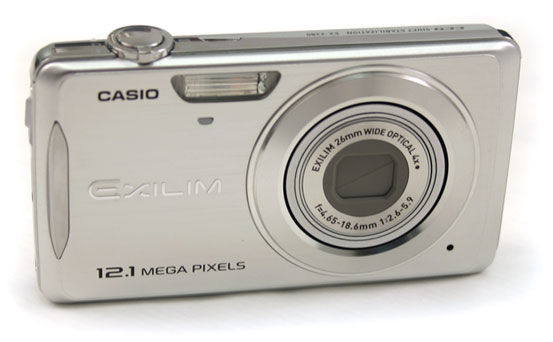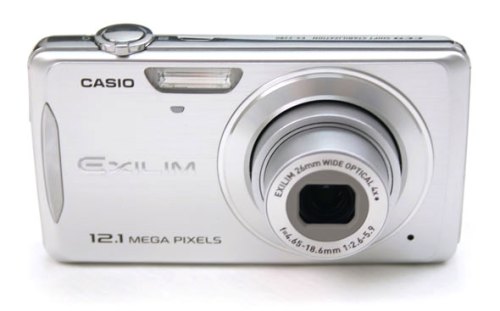“Many of the Z280's best selling points on paper don't quite hold water once you get your hands on it.”
- Inexpensive
- Highly tweakable interface
- Shoots 720p HD video
- Acceptable photo quality
- Plastic case feels cheap
- HD video inferior to dedicated mini camcorders
- Extremely poor, low-resolution display
- Dynamic mode poorly trims out backgrounds
- Blur due to lack of optical image stabilization
Introduction
Casio’s newest entry-level Exilim offers consumers a number of attractive options for its $180 price tag, including 720p HD video capture, a large 2.7-inch screen, and a sleek-looking metallic design. Although we discovered that all of these flagship features come with their own asterisks, the Z280 remains a decent point-and-shoot for the budget-minded novice.
Features and Specs
Casio’s Z280 offers a 12.1-megapixel CCD hiding behind a 26mm wide-angle lens that offers 4x optical zoom. Key features include the ability to capture high-def 720p HD video with a single click, a large 2.7-inch rear display for framing up shots and flipping through options, and extras like dynamic shooting mode, which can automatically mask out images (like a person posing) from a background.
Design and Build Quality
Without a battery, the Z280 almost feels light enough to float away. Add the tiny lithium-ion cell and you might feel safer tying it to a helium balloon, but half the folks who picked it up still told us it felt cheap – a sentiment we have to agree with. An aluminum skin on the front helps sharpen first impressions for those on the other end of the camera, but we it doesn’t quite give off the solid vibe of Casio’s spendier card cameras, or even Canon PowerShots in the same price range.
In its defense, dimensions of 3.87 inches wide, 2.16 tall and 0.79 thick make it pleasantly pocketable, and the same 4 ounce weight (without battery) that we found slightly disturbing also makes it easy to carry around.
Interface
The Z280 uses the same common button layout you’ll find on most point-and-shoot cams: power button, shutter button and zoom control up top, four-way directional pad on the back beside the LCD. Individual eraserhead-sized buttons on the rear switch between video, still images and review modes, and a separate menu button opens up in-depth adjustments.

The biggest departure from the norm may be Casio’s poorly truncated BS button, which opens up a gallery of “BestShot” photo modes. It contains presets for some incredibly niche shooting scenarios, like autumn leaves, as well as background-masking dynamic mode and Auto Best Shot, which attempts to choose the best mode for you.
We like Casio’s standard interface, which offers shortcuts to settings like flash, self timer and resolution on a tab to the side of the image preview, making them easier to view at a glance and change on the fly with the D-pad. It can handle up to eight different settings at once, which users can actually pick and choose from the full slate to get the ones they adjust most frequently. Novice users can also switch to Easy mode, which makes the list of options even smaller and less intimidating for beginners.
Accessories
The box for the Z280 includes the camera, a woven nylon lanyard, and A/V cables for connecting the camera to a standard-def TV (no HDMI output here). Rather than plugging directly into the wall, the tiny charger has its own lengthy AC cable for connecting to an outlet. It makes for a little more clutter to pack when traveling, but one less wall wart on the surge protector under a desk is always a plus at home, and since many laptop power supplies share the same AC cable, there’s a good possibility you’ll be able to leave the Casio cable behind in a pinch.
Display
The 2.7-inch LCD on the Z280 offers only 115K-pixel resolution. That’s an exceptionally low number for a screen that size, and you’ll spot the difference as soon as you flick it on. Even previews of focused images look blurry, menus look rudimentary, and the entire thing smacks of cheapness, like the kind of screen you might find on a camcorder 10 years ago. Even worse, the colors seem to slant to the warm side of the color spectrum, making it almost impossible to judge white balance.

Image Quality
We tested the Z280 at office, at home, and around a drizzly downtown Portland, using automatic shooting as well as various manual settings.
For a camera in this price range, the Casio does a reasonable job keeping digital noise under control. It begins to manifest noise at ISO 400, but not noticeably enough to affect small prints and photos for Web use. By ISO 800, the game is up and noise severely overtakes images.
That doesn’t bode especially well for low-light shooting, but the bigger impingement may be the lack of optical image stabilization. Shooting from the hip in less-than-ideal lighting frequently yielded shots blurred shots that an optically stabilized camera could have salvaged. As some possible consolation for patient shooters, Casio offers an adjustable automatic shutter mode that will wait until movement stops to take a shot.
Although locking in white balance to one of the six presets helps improve color accuracy, relying on automatic white balance frequently yielded pictures that tilted quite heavily toward the warmer side of the spectrum, washing photos with a pinkish hue.
Dynamic mode allows photographers to take two shots – one with a person or object in it and one without – after which the camera will automatically remove the background. In practice, it worked extremely poorly, sloppily slicing around even carefully composed shots and frequently returning error messages.
Overall, the Casio Z280 performed acceptably for its meager price tag, but certainly earns no gold stars for going above and beyond while it’s at it, allowing its cheapness to shine through on many levels.

Video Quality
At $180, the Z280 is one of the most affordable point-and-shoot cams to offer 720p HD video on the market, and is actually cheaper than a number of dedicated HD cameras like the Flip MinoHD, too. We pitted it against our favorite HD cam – Kodak’s $180 Zi8, to compare video quality. Although we shot both in 720p HD mode, the Kodak trounced the Casio in overall quality, turning in more fluid (the Casio only shoots at 23fps to the Kodak’s 30fps), sharp and detailed video. To its credit, the Casio seemed to pull off better white balance in indoor scenes.
Conclusion
Many of the Z280’s best selling points on paper don’t quite hold water once you get your hands on it: The metallic-looking case feels chintzy, the HD video looks choppy, and the 2.7-inch screen has such poor resolution that we would gladly take a smaller model with more pixels. For $180, it still takes reasonably nice pictures under the right conditions, but we wouldn’t go out of our way to recommend it over a slew of similar competitors, including slightly pricier favorites like Canon’s $200 PowerShot SD1200 IS.
Highs:
Inexpensive
Highly tweakable interface
Shoots 720p HD video
Acceptable photo quality
Lows:
Plastic case feels cheap
HD video inferior to dedicated mini camcorders
Extremely poor, low-resolution display
Dynamic mode poorly trims out backgrounds
Blur due to lack of optical image stabilization



